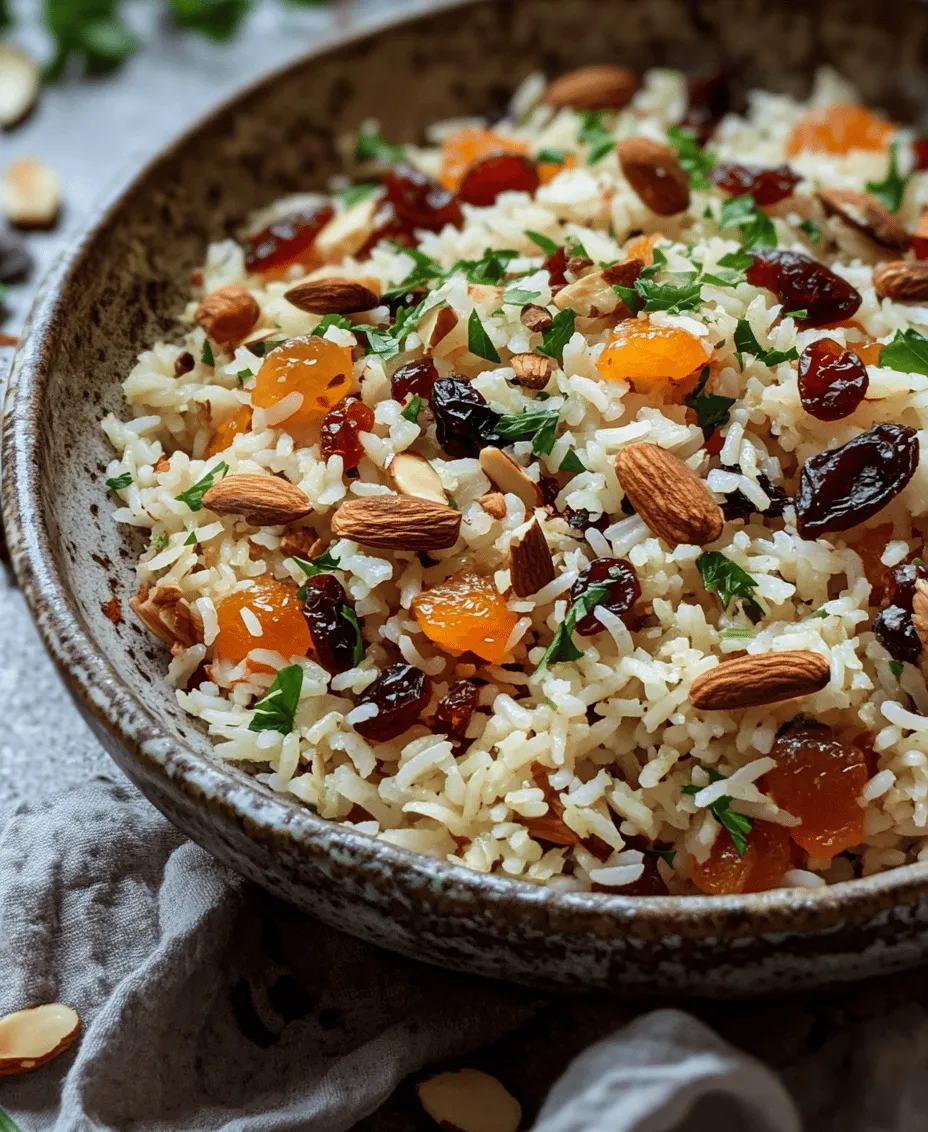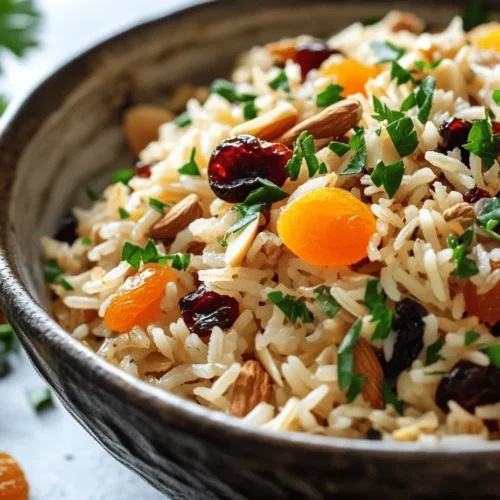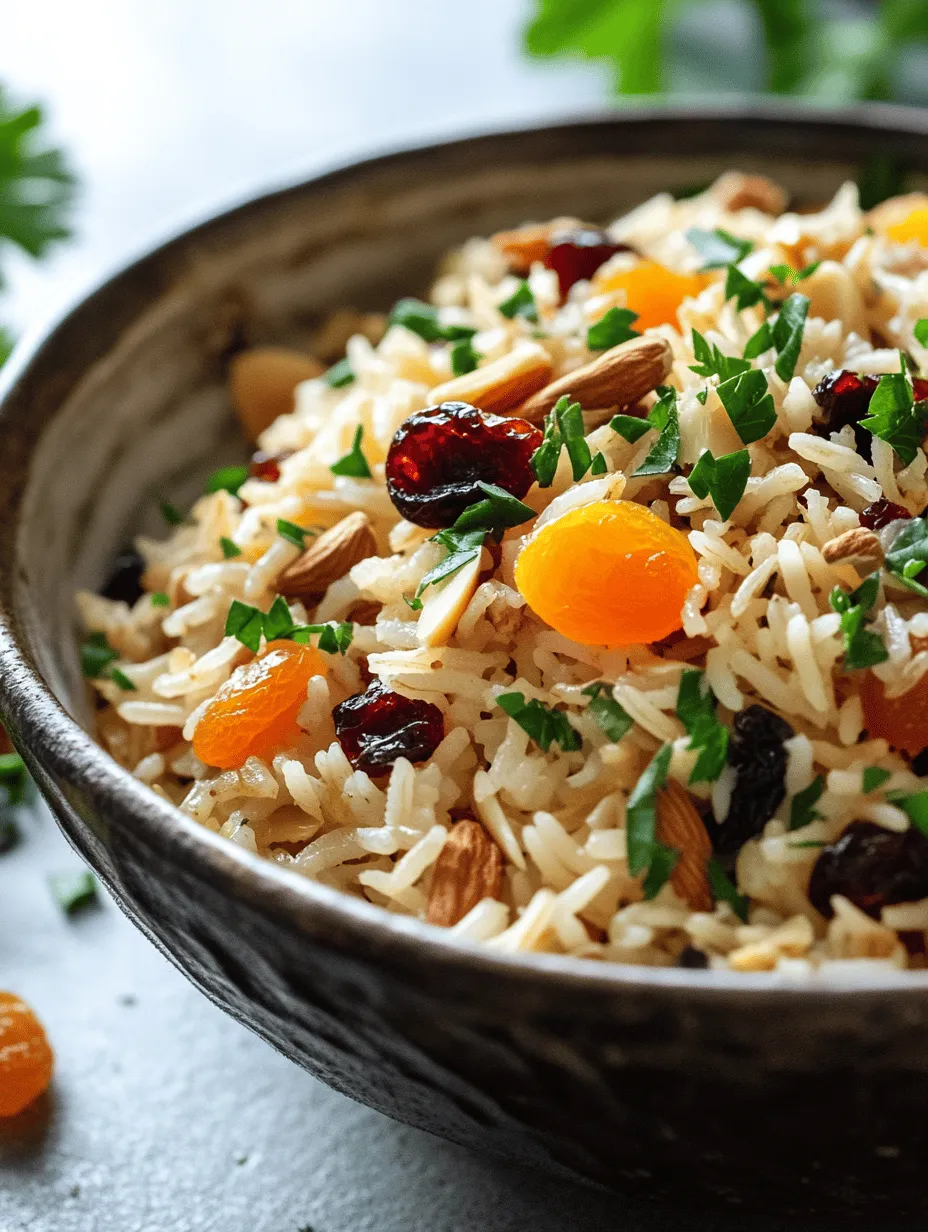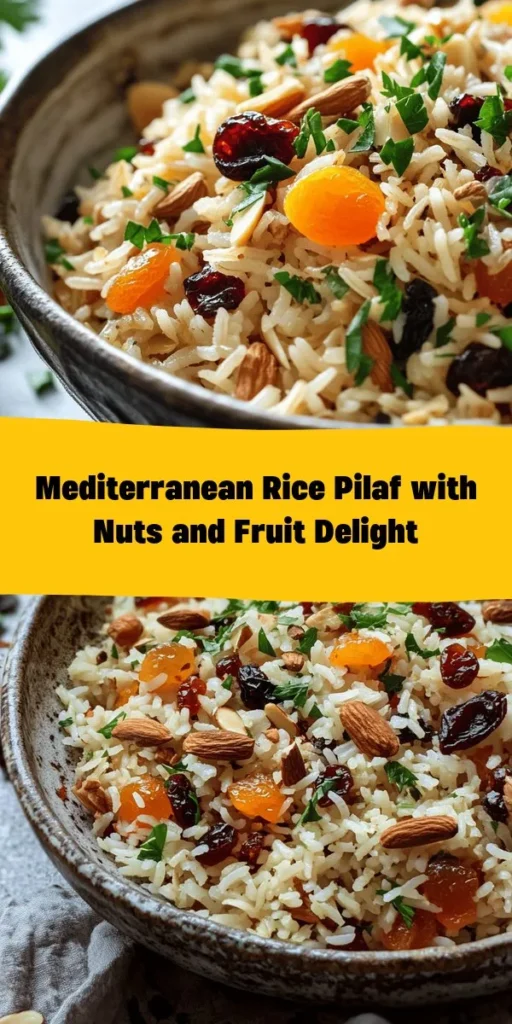Introduction
Mediterranean cuisine is celebrated for its vibrant flavors, fresh ingredients, and diverse culinary traditions that span across several countries bordering the Mediterranean Sea. From the sunny shores of Greece to the bustling markets of Morocco, the cuisine reflects a rich tapestry of cultures, each contributing unique tastes and aromas to the culinary landscape. One of the standout dishes that embodies the essence of this region is the Mediterranean Rice Pilaf, a versatile and flavorful dish that can complement a variety of meals or stand alone as a delightful main course.
Mediterranean Rice Pilaf is not just a simple side dish; it’s a delicious celebration of textures and flavors, featuring the nutty crunch of toasted nuts and the natural sweetness of dried fruits. This dish appeals to a diverse range of dietary preferences, making it an excellent choice for vegetarians, vegans, and meat-lovers alike. The combination of ingredients creates a harmonious balance that is both satisfying and nourishing, ensuring that each bite is an experience unto itself.
The beauty of this Mediterranean Rice Pilaf lies not only in its flavor but also in its simplicity. With just a handful of ingredients and straightforward cooking steps, this recipe invites home cooks of all skill levels to enjoy a taste of the Mediterranean. By incorporating nuts and dried fruit, the pilaf gains added texture and a delightful contrast that elevates it beyond typical rice dishes.
In this article, we will dive into the key ingredients that make this dish special, explore the cooking techniques that enhance its flavors, and guide you through a step-by-step process to create your own Mediterranean Rice Pilaf with Nuts and Dried Fruit.
Understanding the Ingredients
To create an exceptional Mediterranean Rice Pilaf, it is essential to start with high-quality ingredients. Each component contributes to the overall flavor and texture of the dish, resulting in a well-rounded culinary experience. Below, we outline the key ingredients that will elevate your pilaf and provide insights into their significance.
Long-Grain Basmati Rice
At the heart of every rice pilaf is, of course, the rice. Long-grain basmati rice is a popular choice for Mediterranean dishes due to its distinct characteristics. This type of rice is known for its long, slender grains and aromatic qualities, which can enhance the overall flavor of the dish. Basmati rice is also less sticky than other varieties, allowing each grain to remain separate and fluffy after cooking. This texture is crucial for a pilaf, where the rice should be light and airy rather than clumpy.
Vegetable Broth
Using vegetable broth instead of water to cook the rice adds depth of flavor that elevates the dish significantly. It infuses the rice with savory notes that pair beautifully with the other ingredients. For those following a vegan or vegetarian diet, vegetable broth is a fantastic option that ensures the pilaf remains plant-based without compromising on taste. Opt for low-sodium versions to control the salt levels in your dish.
Olive Oil
Olive oil is a staple in Mediterranean cooking, known for its health benefits and rich flavor profile. It serves not only as a cooking medium but also contributes to the overall taste of the pilaf. Rich in monounsaturated fats, olive oil can support heart health while adding a fruity, slightly peppery flavor to your dish. When sautéing the aromatics and toasting the rice, using high-quality extra virgin olive oil can make a noticeable difference in the final result.
Aromatics: Onion and Garlic
Aromatic ingredients like onion and garlic are essential in building the flavor foundation of your Mediterranean Rice Pilaf. Onions provide sweetness and depth, while garlic adds a fragrant, savory element that enhances the overall taste. When sautéed together, they create a beautifully aromatic base that sets the stage for the spices and other ingredients to come.
Spices That Elevate the Dish’s Flavor Profile
The right spices can transform a simple rice dish into an extraordinary culinary experience. In this recipe, we will utilize ground cumin, cinnamon, and nutmeg to achieve a delightful balance of sweet and savory flavors.
Ground Cumin
Ground cumin is a spice with a long history in Mediterranean cuisine. It has a warm, earthy flavor that adds a layer of complexity to the dish. Cumin not only enhances the pilaf’s aroma but also brings a hint of nuttiness that complements the toasted nuts included in the recipe.
Cinnamon and Nutmeg
While often associated with sweet dishes, cinnamon and nutmeg can also create a beautiful contrast in savory recipes. A dash of cinnamon adds warmth and depth, while nutmeg contributes a subtle sweetness that rounds out the flavors. Together, these spices work harmoniously to create a well-balanced pilaf.
Nuts and Dried Fruits: Nutritional Benefits and Flavor Contributions
The addition of nuts and dried fruits not only enhances the texture of the pilaf but also provides a wealth of nutritional benefits.
Slivered Almonds and Walnuts
Slivered almonds and walnuts are excellent choices for this Mediterranean Rice Pilaf. Both nuts are rich in healthy fats, protein, and essential vitamins and minerals. Toasting the nuts before adding them to the pilaf brings out their natural oils and intensifies their flavors, resulting in a satisfying crunch that contrasts beautifully with the tender rice.
Mixed Dried Fruit
Incorporating mixed dried fruit, such as raisins, apricots, or cranberries, introduces a delightful sweetness to the pilaf. These fruits not only add flavor but also contribute natural sugars and fiber, making the dish more wholesome. The burst of sweetness from the dried fruit perfectly balances the savory elements, creating a complex and enjoyable flavor profile.
Step-by-Step Cooking Instructions
Now that we have explored the key ingredients and their importance in the Mediterranean Rice Pilaf, let’s delve into the step-by-step cooking instructions. Following these steps will ensure that you achieve the perfect pilaf every time.
Preparing the Rice
Before you begin cooking, it’s crucial to prepare your rice properly. Rinsing basmati rice is an important step that helps remove excess starch, which can make the rice gummy when cooked. To rinse the rice, place it in a fine-mesh strainer and run cold water over it until the water runs clear. This process may take a few minutes, but it is essential for achieving the desired fluffy texture.
Once rinsed, allow the rice to drain thoroughly while you prepare the other ingredients. This will help to ensure that the rice cooks evenly and doesn’t become overly wet.
Simmering Vegetable Broth
Next, it’s time to prepare the vegetable broth. In a medium saucepan, bring your vegetable broth to a gentle simmer. It’s important to achieve the right temperature before adding it to the rice, as this will help to maintain the cooking process and prevent the rice from becoming mushy. A simmering broth will also infuse the rice with flavor more effectively than cold liquid.
Sautéing the Aromatics
In a large skillet or saucepan, heat a couple of tablespoons of olive oil over medium heat. Once the oil is shimmering, add the diced onion and sauté for about 3-4 minutes, or until it becomes translucent. Next, add the minced garlic and continue sautéing for an additional minute or until fragrant. Be careful not to let the garlic burn, as it can turn bitter and affect the overall flavor of your pilaf.
Timing for Adding Spices
After the aromatics have softened, it’s time to add your spices. Sprinkle in the ground cumin, cinnamon, and nutmeg, stirring continuously for about 30 seconds to release their essential oils and enhance their aroma. This step is crucial for maximizing the impact of the spices in your dish.
Toasting the Rice
With the spices now aromatic and the onions and garlic softened, it’s time to add the rinsed basmati rice to the skillet. Stir the rice into the mixture, ensuring that each grain is coated in the flavorful oil and spices. Toasting the rice for about 2-3 minutes will enhance its nutty flavor and provide a beautiful base for the pilaf. This step not only adds depth to the dish but also helps to lock in the flavors before the rice is cooked.
As you follow these initial steps, you will be well on your way to creating a delicious Mediterranean Rice Pilaf with Nuts and Dried Fruit. The combination of aromatic spices, toasted rice, and the sweetness of dried fruit will create a dish that is both satisfying and memorable. Stay tuned for the next part, where we will continue with the cooking process and explore how to bring all the elements together for a delightful dining experience.

Cooking the Rice
When it comes to making Mediterranean Rice Pilaf, the cooking method is crucial. The classic technique for preparing rice pilaf involves simmering, which not only enhances the flavor but also ensures that the rice grains achieve the perfect texture. Start by adding your rinsed rice to a pot with sautéed onions and garlic, followed by the broth or water. Bring the mixture to a boil over medium heat, then reduce to a gentle simmer. Cover the pot with a lid to trap steam, which will cook the rice evenly.
Simmering and Its Effect on Rice Texture
Simmering allows the rice to absorb the liquid gradually, leading to tender grains that remain separate rather than sticky. This method is particularly effective for long-grain varieties such as basmati or jasmine rice, which are commonly used in Mediterranean cuisine. Keep the heat low to avoid boiling, as rapid cooking can cause the rice to break and become mushy.
Tips on Knowing When the Rice Is Done
To determine if your rice is ready, check for a few key indicators. After about 15-20 minutes of simmering, lift the lid and taste a grain. It should be tender yet firm to the bite. If the rice is still crunchy, cover it again and allow it to simmer for a few more minutes. Additionally, look for small holes on the surface of the rice, which indicate that the grains have absorbed most of the liquid. Once done, remove the pot from heat and let it sit covered for another 5-10 minutes to allow the steam to continue cooking the rice and to promote fluffiness.
Toasting the Nuts
Toasting nuts is a simple yet impactful step in elevating the flavor profile of your Mediterranean Rice Pilaf. Nuts, such as almonds and pine nuts, add a delightful crunch and richness that complements the dish beautifully.
Techniques for Toasting Nuts: Achieving the Perfect Crunch
Begin by preheating a dry skillet over medium heat. Once hot, add the nuts in a single layer. Toasting nuts is a quick process, usually taking about 3-5 minutes. Stir frequently to ensure even toasting and prevent burning. You’ll know they’re done when they emit a fragrant aroma and take on a golden-brown color.
Importance of Timing to Avoid Burning
Burnt nuts can impart a bitter flavor to your dish, so it’s essential to keep a close watch. If you notice that the nuts are starting to darken too quickly, remove them from the skillet and transfer them to a plate to halt the cooking process.
Final Assembly
With your rice cooked and nuts toasted, it’s time for the final assembly of your Mediterranean Rice Pilaf.
Fluffing the Rice and Mixing in Nuts, Dried Fruit, and Parsley
Using a fork, gently fluff the rice to separate the grains. This step is crucial, as it prevents the rice from clumping together. Once fluffed, add in the toasted nuts, dried fruits like raisins or apricots, and freshly chopped parsley for a burst of color and freshness. Mix these ingredients gently to combine, taking care not to mash the rice.
Balancing Flavors with Salt and Pepper
Taste your pilaf and adjust the seasoning with salt and pepper as needed. This step is vital for enhancing the overall flavor of the dish. Remember, the dried fruit adds sweetness, while the nuts provide a nutty flavor, so balance them with the right amount of salt to create a harmonious dish.
Serving Suggestions
Presentation matters, especially when serving a dish as vibrant as Mediterranean Rice Pilaf.
Presentation Ideas for Serving Mediterranean Rice Pilaf
Serve the pilaf in a large, shallow dish or individual bowls. Garnish with additional parsley, a sprinkle of pomegranate seeds, or a drizzle of olive oil for an appealing presentation. Accompany the pilaf with lemon wedges for a zesty touch that diners can add according to their taste.
Complementing Dishes That Pair Well with the Pilaf
This pilaf pairs wonderfully with various proteins and side dishes. For a complete meal, consider serving grilled chicken marinated in lemon and herbs, or pan-seared fish such as salmon or sea bass. For plant-based options, roasted chickpeas or sautéed tofu can add protein and flavor.
Suggested Proteins: Grilled Chicken, Fish, or Plant-Based Options
Grilled chicken breast, especially when marinated in Mediterranean spices, complements the flavors of the pilaf beautifully. Alternatively, consider a flaky white fish seasoned with garlic and herbs. For vegans and vegetarians, roasted vegetables or a chickpea salad can enhance the meal without overpowering the pilaf.
Side Dishes: Salads or Roasted Vegetables
Accompany your Mediterranean Rice Pilaf with a fresh Greek salad made with cucumbers, tomatoes, olives, and feta cheese for a refreshing contrast. Alternatively, roasted vegetables like zucchini, bell peppers, or eggplant seasoned with olive oil and herbs can add depth to your meal.
Nutritional Analysis
Understanding the nutritional profile of Mediterranean Rice Pilaf can help you appreciate its health benefits.
Breakdown of the Nutritional Content of the Dish
This dish is not only delicious but also nutritious. Each serving of Mediterranean Rice Pilaf is rich in dietary fiber, vitamins, and healthy fats. The combination of rice, nuts, and dried fruit provides a well-rounded dish suitable for various dietary needs.
Health Benefits Associated with the Main Ingredients
The nuts contribute healthy fats and protein, essential for maintaining energy levels and overall health. Dried fruits, while sweet, are packed with antioxidants and essential nutrients that support immune function and digestion. The herbs and spices used in the dish also provide anti-inflammatory benefits.
Dietary Fiber from Nuts and Dried Fruit
Nuts like almonds and walnuts are excellent sources of dietary fiber, which aids digestion and promotes satiety. Dried fruits, such as apricots and raisins, contribute additional fiber, making this pilaf a fulfilling dish that can help regulate blood sugar levels.
Antioxidants and Healthy Fats
The nuts not only provide crunch but also deliver essential fatty acids, which are crucial for heart health. Antioxidants in dried fruits can help combat oxidative stress, making this dish a flavorful way to support a healthy lifestyle.
Discussion on Serving Size and Healthy Eating Considerations
When it comes to serving size, a standard portion of rice pilaf is about 1 cup. This size is both filling and nutritious. For balanced meals, consider pairing the pilaf with a protein source and a side of vegetables to meet your dietary needs.
Cultural Significance of Rice Pilaf in Mediterranean Cuisine
Rice pilaf holds a significant place in Mediterranean culinary traditions, reflecting the region’s rich history and diverse cultures.
Historical Context of Rice Pilaf in Mediterranean Cultures
Originating in the Middle East and spreading to various Mediterranean countries, pilaf has evolved over centuries. It is believed to have been influenced by Persian cuisine, where rice is often cooked with spices and served at feasts.
Variations of Rice Pilaf Across Different Countries
Each Mediterranean country boasts its own unique take on rice pilaf. For instance, in Turkey, pilaf might include spices like saffron, while in Greece, it may be prepared with lemon and herbs. The Spanish have their version known as “paella,” which incorporates saffron and seafood.
The Dish’s Role in Festive Meals and Family Gatherings
Pilaf often takes center stage at festive meals and family gatherings, symbolizing hospitality and abundance. It is commonly served during celebrations, weddings, and holidays, making it a cherished dish across cultures.
Conclusion
The Mediterranean Rice Pilaf with Nuts and Dried Fruit is a delightful fusion of flavors and textures that embodies the essence of Mediterranean cuisine. Its versatility allows it to be enjoyed as a side dish or a main course, making it a staple in many kitchens. Encouraging exploration of Mediterranean flavors can enrich your cooking repertoire and introduce new tastes to your meals. By incorporating diverse ingredients like nuts and dried fruit, you not only elevate the dish’s flavor but also enhance its nutritional value. Embrace the vibrant and wholesome characteristics of Mediterranean cuisine and enjoy the delicious journey it offers.



